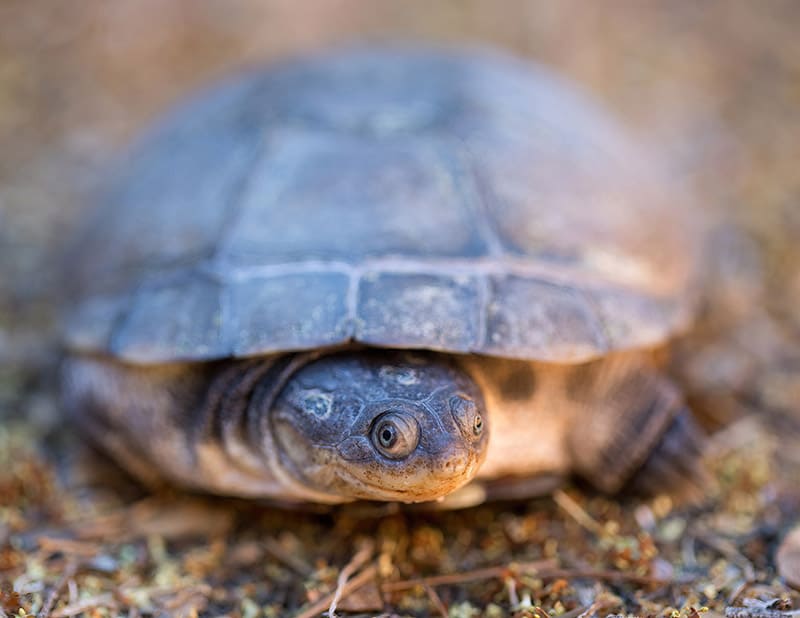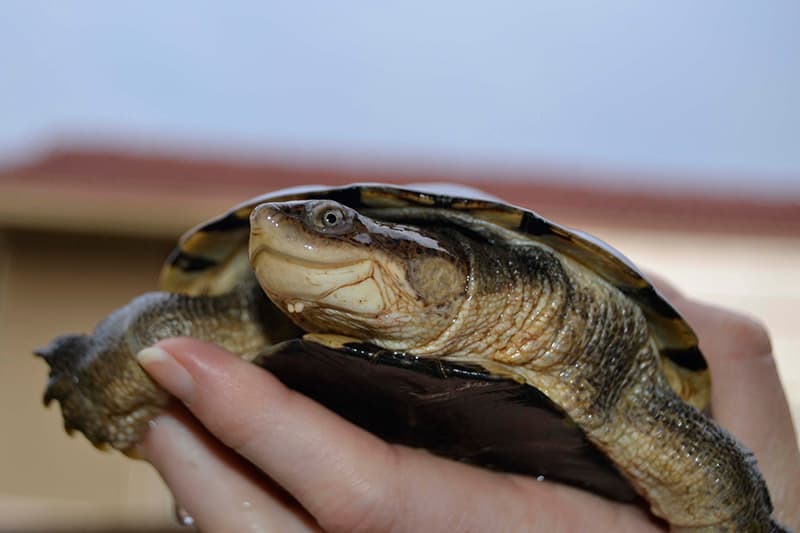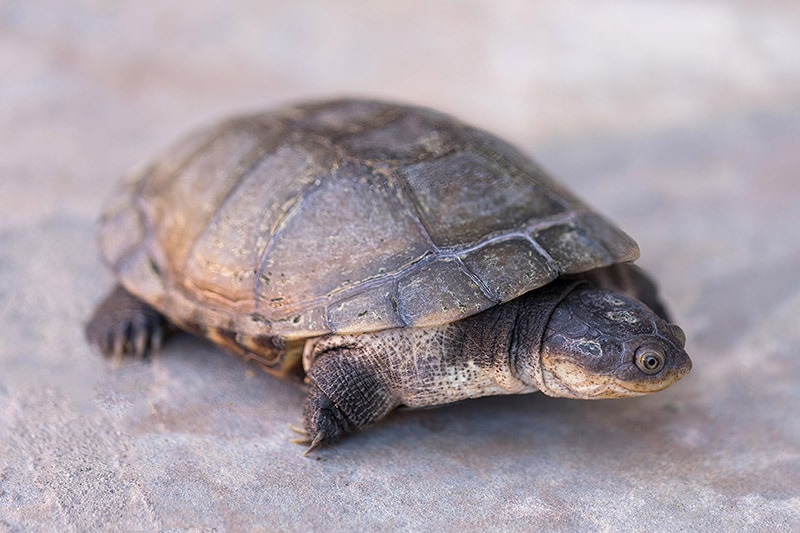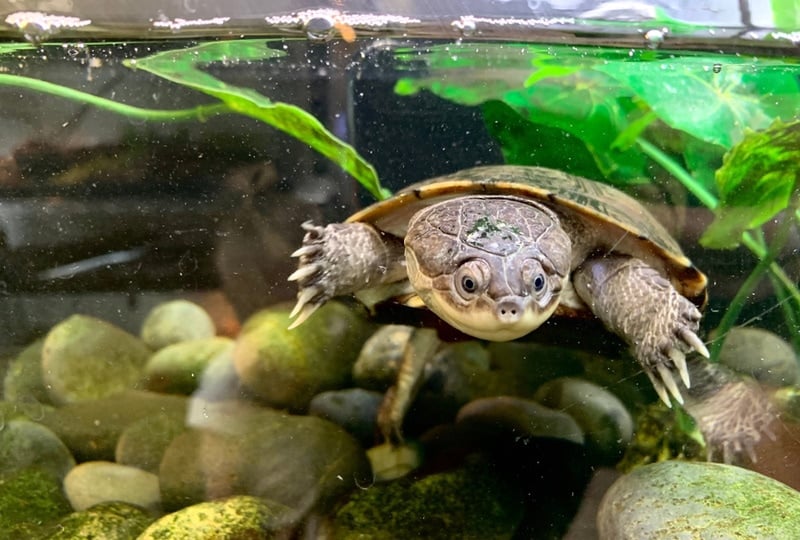With a naturally upturned “smile” and a pug nose, the African Side-necked Turtle has a great face!
The African Side-necked Turtles or African Mud Turtles have gained in popularity in recent years. There are 15 species in the Pelusios genus, along with a single member in the Pelomedusa genus, Pelomedusa subrufa, known as the African Helmeted Turtle. These active turtles are hardy and curious (and somewhat aggressive). They are also prolific breeders and live a long time. Shy at first, these turtles acclimate well and quickly exhibit their inquisitive nature.
Most African Side-necked Turtle species can be kept in relatively simple enclosures as they have fairly modest requirements. They like to have a place to swim and also love basking, especially in groups. When basking they are alert but very shy, plopping into the water at the approach of their keeper. They will soon become tame however, and though they dive off into the water of the enclosure, will quickly surface to see if any food has been offered.
Turtles don’t instill the cautious concerns that some folks have when dealing with other types of reptiles. However, adult females of most species of African Mud Turtles get larger than most first-time pet buyers realize, with adult females reaching 9-12″ inches within five or six years. Also, when threatened these turtles can exude a horrible musk odor. This is most often exhibited by wild-caught specimens. Fortunately after settling into captivity they rarely exhibit this behavior.
- For more information see: Selecting and Caring for Your Turtle or Tortoise
Scientific Classification
| Kingdom: | Animalia |
| Phylum: | Chordata |
| Class: | Reptilia |
| Order: | Testudines |
| Family: | Pelomedusidae |
| Genus: | Pelusios |
| Species: | sinuatus |
Distribution
This group of turtles are known as the African Side-necked Turtles or the East African Serrated Mud Turtles. They are classified in the genus Pelusios and Pelomedusa and belong to the family Pelomedusidae. There are fifteen species in the Pelusios genus found in Africa, the Seychelles, and Madagascar. Pelomedusa subrufa, the single species in this genus, is found throughout much of Africa and on Madagascar.

Status
These turtles are not listed on the IUCN Red List.
Description
Some specimens are lighter in color, such as a dark brown and even tan, but generally the African Side-necked Turtles are gray to black overall with dark skin. They vary in size, P. castaneus adults grow up to 12″ (30 cm) in length and P. sinuatus adults to 20″ (50 cm). Pelomedusa subrufa remains small, reaching only 6″ to 8″ (15 cm to 20 cm) in length.
Care and Feeding
African Side-necked Turtles feed eagerly on commercial aquatic turtle food and will eat fish, crayfish, worms, and even crickets. They will also pick at aquatic plants and especially enjoy taking bite-sized pieces from the leaves of water hyacinth and water lettuce.
Environment
In the wild, African Side-necked Turtles or African Mud Turtles are found in a variety of habitats from rivers and shallow pools to large lakes. In captivity most can be kept in relatively simple enclosures. They are tolerant of a wide variety of water conditions but will do best in 8 -10″ of clean, filtered water. They are avid group baskers and will plunge excitedly into the water when approached. They usually swim a short distance and then quickly surface in case the visitor has food to offer. The enclosure should feature a variety of decorations including piles of rocks and driftwood for basking. Decorations and aquatic plants add variety and provide hiding places for smaller turtles, subordinate males, and females uninterested in the courtship advances of aggressive males.
- Larger species: The larger turtles such as P. sinuatus and P. gabonensis can be set up in pairs or trios in large aquariums (75-gallon to 100-gallon) or larger tubs and stock tanks.
- Smaller species: The smaller turtles such as P. subniger, P. castanoides, and Pelomedusa can be set up in pairs or trios in 60-gallon aquariums or medium tubs and stock tanks.
Care must be taken that these, and any turtles, are not released into a wild habitat. The reasons are many. The introduction of non-native species can lead to the introduction of diseases and can lead to hybridization of introduced and native species. In addition, many turtles raised in captivity and released into wild situations are confused, unable to cope with extreme weather changes, and many surely fall prey quite quickly to the wary predators they may encounter.

Handling
Captive-hatched specimens, as always, are the best to keep as pets and most will become so docile that they can easily be fed by hand. These and all aquatic turtles should be considered wonderful display animals and not pets that are easily held.
Breeding
African Side-necked Turtles are prolific breeders and females can lay multiple clutches each year. While egg-laying, females bury themselves deeply, even up to the base of their front legs. The depth achieved could be a defensive strategy against monitors or other egg-eating predators or could be a safety measure to allow eggs to avoid the extreme heat and drying potential of the hot African sun close to the surface of the laying area.
Baby African Side-necked Turtles are hardy and grow quickly. Keep them in an aquarium with clean filtered water, warmth, UVB rays, and a few sturdy basking sites. They feed well on a variety of food. They relish small invertebrates, especially worms, and they quickly begin eating commercial aquatic turtle food. Keep aquatic plants such as Cabomba, Anacharis, or duckweed in their enclosure to satisfy their herbivorous needs.
Ailments / Health Problems
None if kept properly, these are tough turtles! Once their parasites have been removed they settle well into captivity.
- Shell Damage: Typically, African Side-necked Turtles arrive with varying amounts of shell damage. Minor cases heal well if treated with a Betadine® scrub and if the turtles are kept in a warm, sunny environment. More serious cases may require treatment with Silvadene® cream. Access to direct sunlight helps immensely with treating most shell problems.
- Parasitic worms: (nematodes) are often found in newly imported specimens and they should be deparasitized with Panacur® within a short time after they have established and started feeding well.
- Eye problems: Occasionally, imported African Side-necked Turtles exhibit a variety of eye problems. These are typically the result of dehydration and poor conditions during shipping and can range from a minor filmy covering to more severe swelling. Filminess will usually disappear within a few days of placing them into clean, filtered water. More severe problems may require the application of an ophthalmic antibiotic. A good basking spot and plenty of sunlight as well as good water quality will prevent most eye-related problems.
- Respiratory problems: Though somewhat cold hardy, when exposed to cold weather for an extended period of time, these turtles are prone to respiratory problems.

Availability
African Side-necked Turtles or African Mud Turtles are commonly imported from Africa, but captive-hatched specimens are the best pets. These can be purchased from better pet stores, from breeders at the larger reptile shows across the country, and on-line.
Featured Image Credit: Megan Czarnocki, Shutterstock
